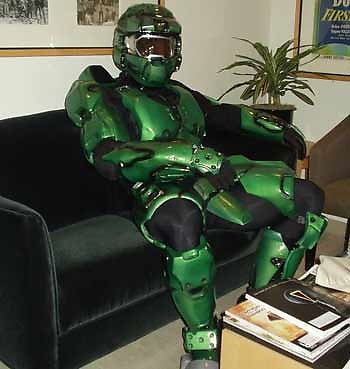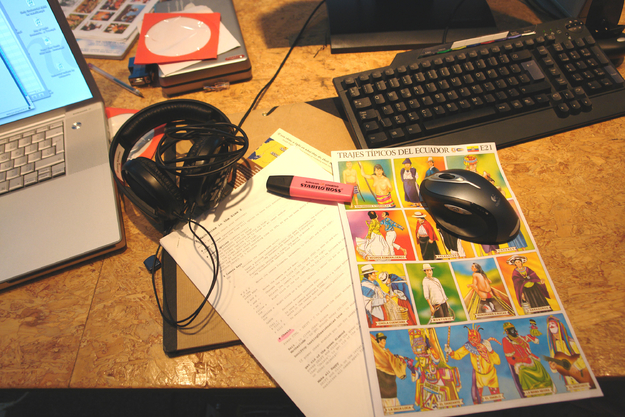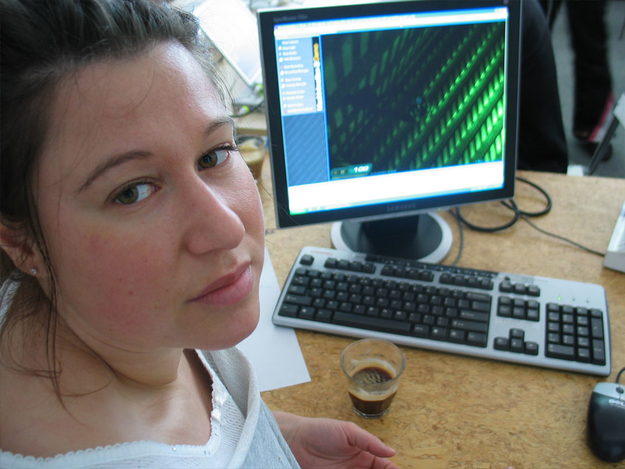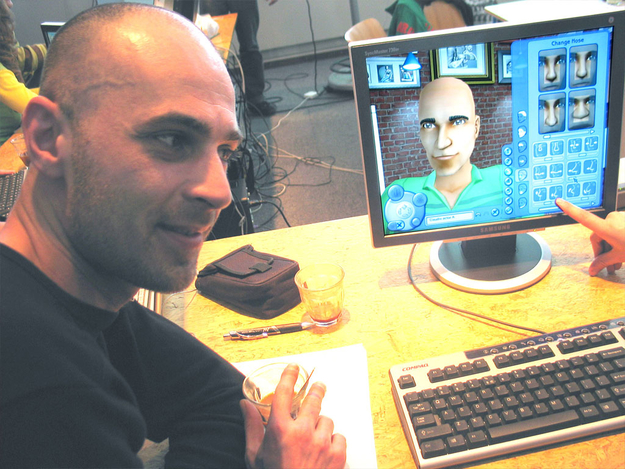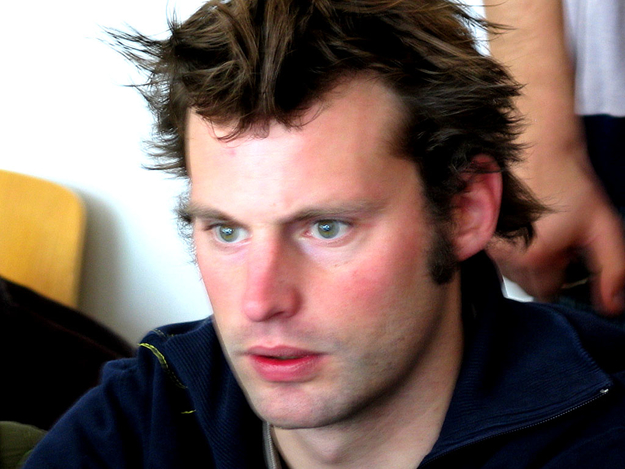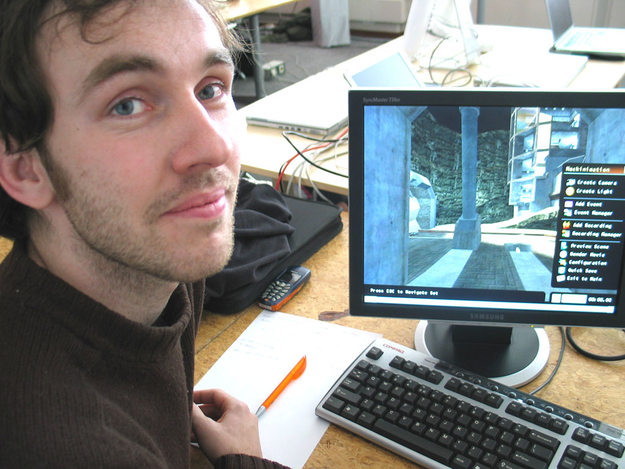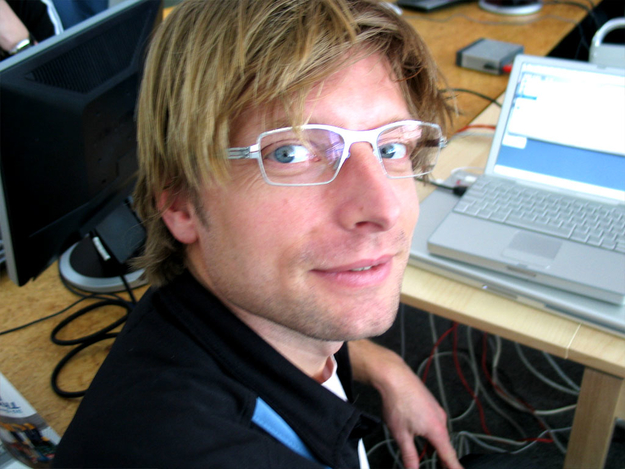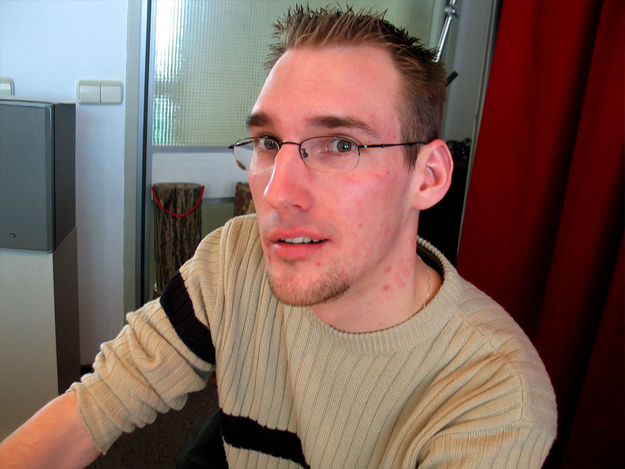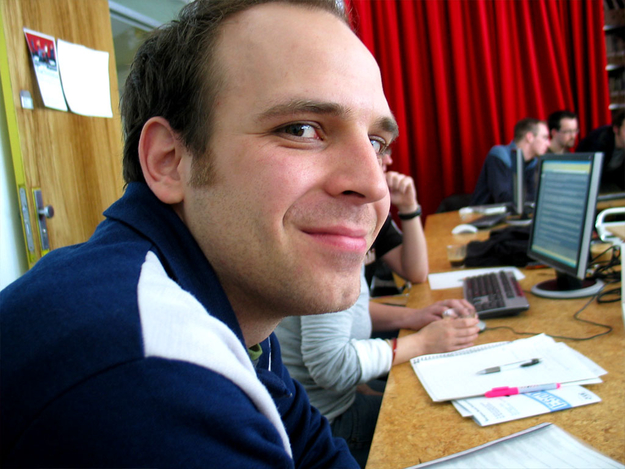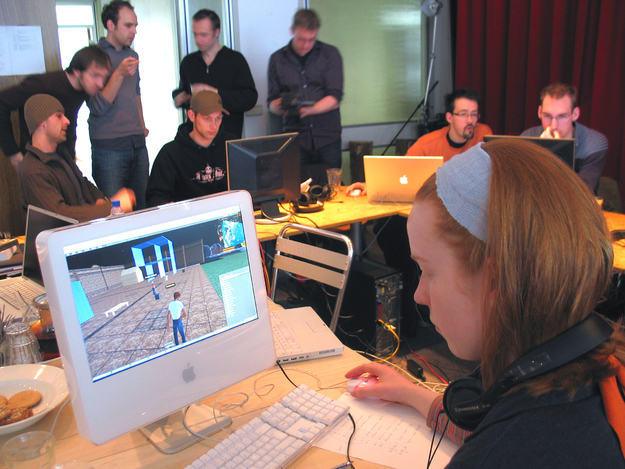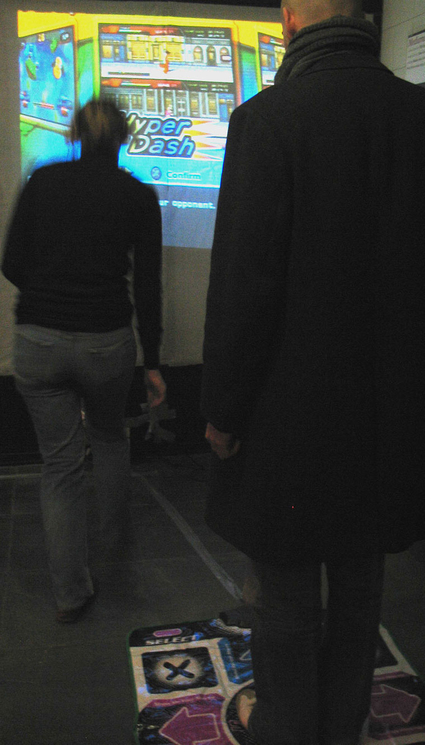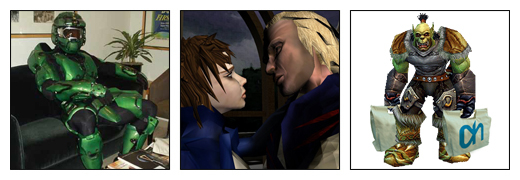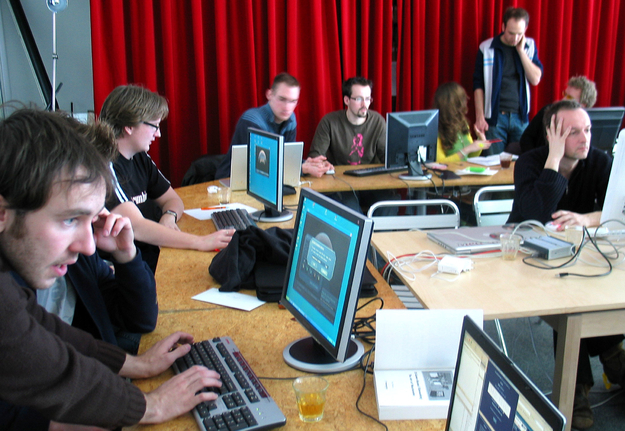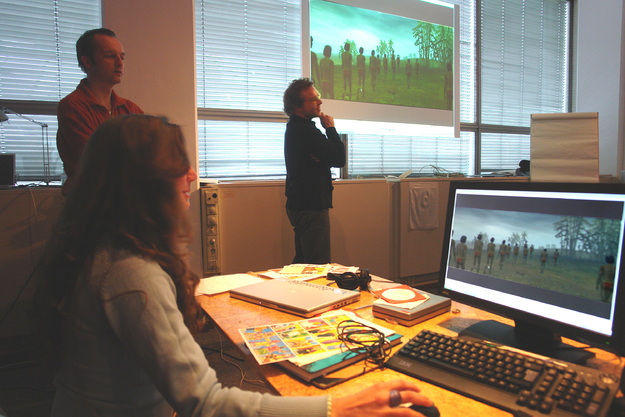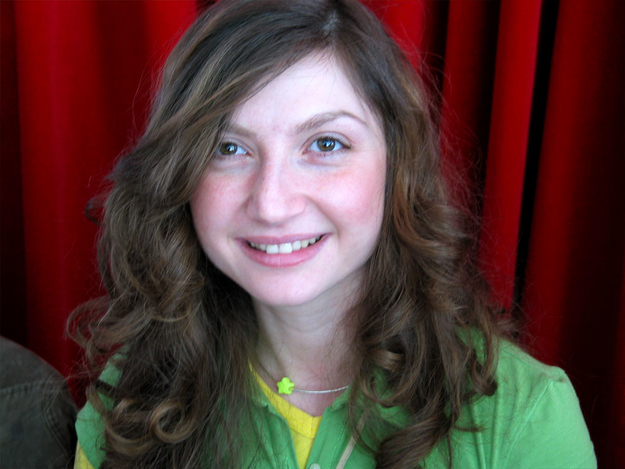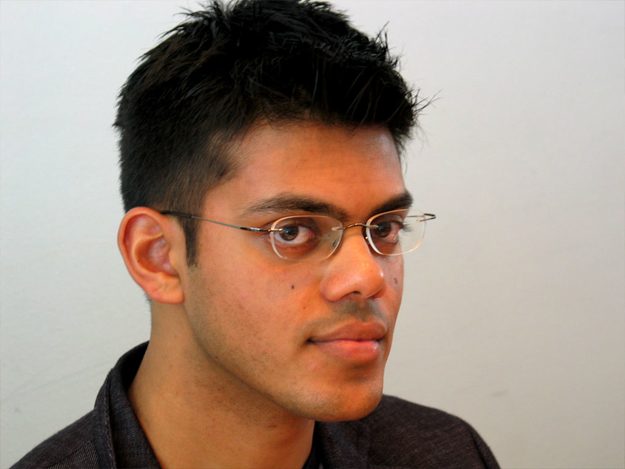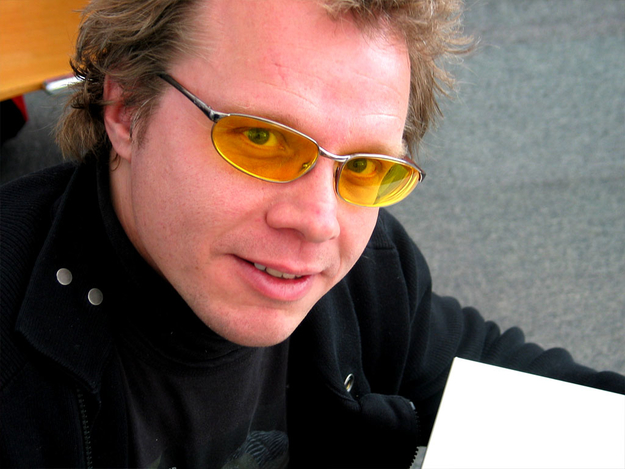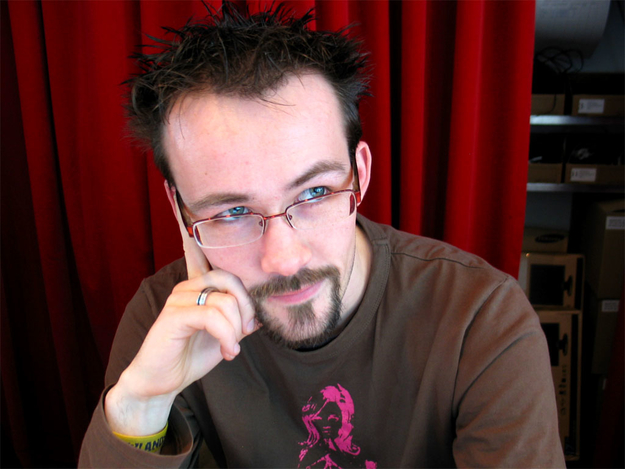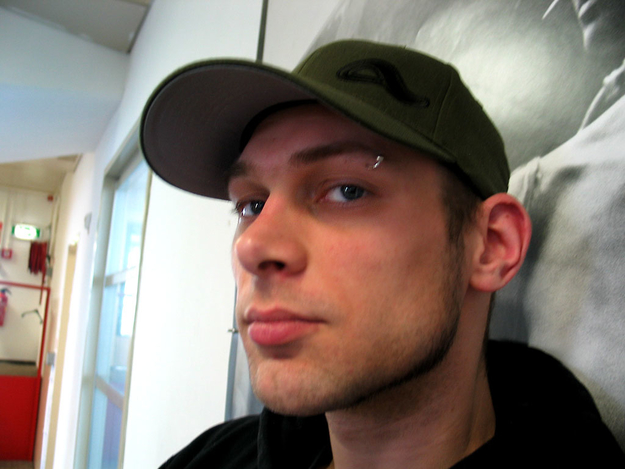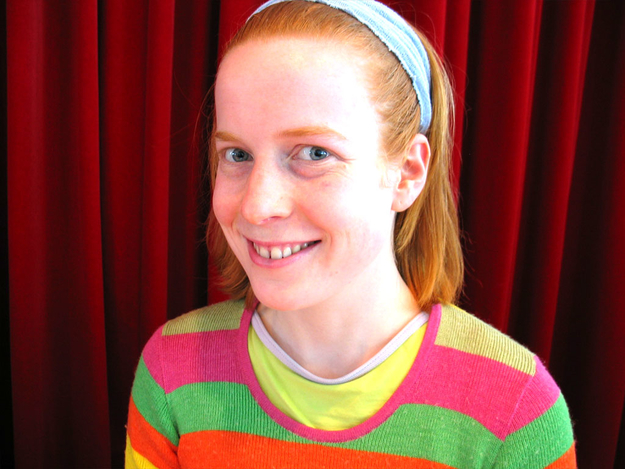Machinima delivers traditional assets of big budget filmmaking (things like fancy vehicles, large fantastic sets, explosions and big-ass weaponry) in the hands of smaller budget artists and media makers. Possibilities like re-camming (changing or adding sets and characters and props after shooting) and camera scripting will also have profound cinematic implications for the ways in which independent filmmakers work. The contiuous increase in the visual possibilites of 3D engines is spreading Machinima’s popularity rapidly beyond the initial boundaries of the gaming subculture.
Workshop approach
In this workshop traditional film making techniques were combined with real-time scripting within a virtual environment. Participants were guided through Machinima production process by experts from the fields of gamedesign and animation. Besides technical instructions on set design, character creation, re-camming and post production, we focused on cinematic and artistic possibilities of shooting film in 3d engines.
Trainers and speakers
Mark Meadows (US) - artist, 3D animator, game developer
Electronic pioneer Mark Meadows lives between art and design, science and technology. His 3D animation and interactive design works have been flown by a list of companies that include Lucasfilm, Sony Pictures, and Microsoft.
Friedrich Kirschner (Germany) - machinimamaker, editor Machinimag
Friedrich’s Machinima series Person 2184 won him awards for best Technical Achievement and best Visual Design at the 2005 Machinima Film Festival, and has been showcasted at numerous others. Also, he writes for Machinimag and is teammember of the Ars Electronica Center.
Daniël van Gils (NL) - interaction designer, machinima educator
Daniël worked as creative programmer at IJsfontein in Amsterdam, and recently set up a Machinima course for his students at the Academy for Communication and Multimedia Design in Breda.
Jonas Hielscher (Germany) - designer interactive / educative game installations, co-founder z25.org
Jonas is currently completing the Masterprogram Mediatechnology at Leiden University. He founded z25.org, an organization that supports young new media artists, and has built a range of interactive performance and gaming installations.
Target group
This workshop is intended for filmmakers, animators and gamers, who are interested in each others arts. Some experience with playing video games or film editing is helpful, but not essential.
Reader
In preparation for this workshop a collection of books, articles and media has been put together in the Machinima Reader.
Workshop Report
The first machinima workshop at Mediamatic has finished. After four days of gaming, deconstructing video game engines, filming, editing and sound mixing, all participants were able to show their short films in different states of completion, but all with promise. Among the films produced there was an awareness film about the destruction of the Ecuadorian rainforest, a science fiction kidnapping scene, a discursive project of acting-in-acting inside different game engines, a dance scene, a romance between a man and his gun and a comic scene of what happens when real live footage appears inside a game environment. But how did it all come to be? And how do the participants look back on the workshop?
Machinima: an introduction
Machinima, the art of making films inside computer games, has been around from the early 90’ies. In the opening lecture by Friedrich Kirschner, Friedrich gave an overview of the history and current practices of machinima. Friedrich states that it all began with the first Doom game by iD software. Another breaktrough was the possibility to recam scenes inside the game Quake 2, again by iD software. After these important steps, machinima took a flight and grew larger and larger as a phenomenon. In recent years machinima were also recognized by other fields of interests which saw potential in its easy configuration and real time footage.
After this introduction to machinima in general, Mark Meadows continued the theoretical framework, by diving into character development: key aspect of any serious movie attempt. Presenting a new character model for facial animation, Mark underlines the notion that we are entering a more dramatic era of gaming and machinima. Drama that calls for more convincing performances by virtual actors.
Enter the game
But how are we to unlock all these possibilities? Deeply imbedded into game culture, making machinima needs you to think as a gamer. Machinima are the result of play and thus plays by the rules of the game. The rules can be bent, changed and deconstructed, but prior to that there needs to be an understanding of the game itself. The participants were guided in this by Daniel van Gils and Friedrich Kirschner. After getting to know the different games and seeing some of the basic possibilities, it was time for the participants to get hands on with their own machinima. First step was gathering possible scenario-ideas and the forming of teams of people with the same interest.
The second day, Daniel van Gils introduced the participants to the world behind the game. With the Machinimation 2 tool, based on the Doom 3 engine, Daniel showed how the participants could make their own maps, place lights and actors in those maps and explained how things like textures and bump maps work. With this new knowledge the teams needed to finish their scenarios and start to experiment with the different game engines they were going to use for their machinima.
The third day kicked off again with a workshop by Daniel and Klaas, this time on the use of sound. Daniel showed how game editors make use of sophisticated 3D sound engines and how sound can be imported into the game environment. Klaas showed some resources the participants could use for finding free and useable sounds and music. After this lesson everybody got back to work and continued there projects.
The fourth and final day of the workshop was a day with the motto: “Less talk, more work". All the teams where working their hardest on finishing their shoots, editing the material, placing sounds under their movies and rendering out movie-files of their projects. Under the guidance of Jonas and Daniel everybody tried to finish their projects as much as possible and in the final presentation it all came together: the fruits of the workshops came on display! Some groups had a finished moviefile, but others had a different approach, like a live performance inside their created environment.
And with the screenings and live performances a fruitful workshop came to an end. Four days of intensive working, thinking, debating and promising projects is what everybody took home with them and hopefully will still think of many times.
Impressions from the participants
Stefan Kosters
Stefan, a former intern at Mediamatic, returned to participate and see how everything came together in this workshop. Teaming up with Claudiu, he made an interesting discursive movie about acting-in-acting. Two “The Sims 2" characters, made to look like Claudio and himself, are making a machinima within the Quake 3: Arena environment. Switching over to the Quake 3: Arena engine, we witness the movie presumably made by the two Sims only to discover at the end that these two characters are making a machinima of the two Sims characters, providing the viewer with a big "chicken or egg" question.
Claudiu Iurescu
As a contemporary media artist Claudio Iurescu is interested in pretty much everything concerning interactive media. The hands-on approach of the workshop and the theoretical background provided by the speakers made for a fruitful workshop: “The deadline got everyone working there hardest for producing some good material and mastering the technique as fast as possible." and Claudio found that: “Machinima is a medium on the border between game and film, public and private space and thus provides a playground to explore and shake the borders of these spaces."
Rini Hartman
Rini came to the workshop with an ambitious project. Working on an awareness program for the destruction of Ecuadorian rainforest by oil waste, he wanted to use machinima to portray the destruction and consequences of our Western consumption of natural resources. The result is a collage of footage from 4 different games which blend together to convey the message. Rini: “Friedrich was the one who opened our computers and minds to think out of the box. He provided us with the technological insights to open up the technology and make it work for us."
Anne Gentenaar
Anne is a graduate student at the IMVFX (Interactive Media and Visual FX) department of the Dutch Film Academy. Working on her graduation project Anne made some free time to attend the machinima workshop. The machinima workshop was a refreshment for Anne. The workshop provided a fresh and new framework for filmmaking. “Machinima aim for diverse and new ways of filming, it is a democratisation of media and calls for workarounds and creative solutions."
Catherine Kahn
Catherine is a visual dramaturge and concept developer. At the moment she is developing concepts for interactive teen shows for IPtv. (a collaboration of the Norwegian film-development and Media plus): “It is the mixture of several creative platforms involving machinima, that forms the way to go for a new generation of film makers! I am completely in love with what 3D technology and its games and toolboxes can do and it is taking storytelling to a new level with its gnomes and orcs and even though I am a novice in this, I am a novice completely in love."
Daniel van Gils
Daniel is a freelance new media developer working for very diverse projects. Reconfiguring technology for new and interesting purposes. Besides this he is a teacher in game-development working with groups of students on many different projects. He also started with a machinima class. Very skilled in modding, Daniel can dive deep in the technicalities of game editors and is able to repurpose its contents from within the editors and create something new out of it.
Neda Gueorguieva
Neda is a graduate student at the Dutch Film Academy. Studying at the IMVFX (Interactive Media and Visual FX) department she has worked with digital animation techniques for quite some time, but machinima was a new and unexplored way of making digital animations: “For me the challenge was not so much in the technique of making the film inside the game, but mastering the game to produce the film you want to make inside the game! For example: I needed to learn how to fly a helicopter in Battlefield 2 to make the aerial shots for our film, and I tell you: it is quite difficult!"
Friedrich Kirschner
Friedrich is a machinima maker, even an award winning machinima maker. Promoting the notion of machinima and modding as ‘creative play’ Friedrich wants us to delve deep within the game and appropriate its contents for our own uses. As seasoned machinima maker he was an invaluable resource for the machinima workshop. Opening the eyes of many participants for the different ways that could be walked towards a machinima production, Friedrich encouraged the participants to experiment with the technology and thinking out of the box.
John Vergeer
John’s primary interest in machinima is for the production of pre-visualizations (previs) of movie scenes. John: “Traditional 3D animation software like 3D StudioMAX or Maya can’t easily make a motion preview of how a scene will look like and rendering it for a test is much too time-consuming. Machinima on the contrary is real-time and can easily make a full motion previs."
Joachim Stein
Primarily working as a technical consultant for cultural institutions, Joachim is confronted with many different people and problems. In his remaining time he’s a conceptual artist making works, which are as de-materialized as possible. His project in the workshop was focused on conveying emotional interaction between in-game characters. Using the world of Second Life he was amazed by the possibilities the medium provided him with. Joachim: “The vast world of Second Life lets you do anything you would like to do in it."
Jonas Hielscher
As a Master Student in Media Technologies at Leiden University Jonas is familiar with computer interfaces and the practice of machinima. He was trainer at a Sims 2 machinima workshop for kids at the Cinekid Festival. Jonas himself was also quite surprised by the results of the workshop: “My view on machinima has broadened very much, the combination of the four trainers was very fruitful and I learned and experienced many new things about machinima."
Ricardo Varma
Ricardo is working on a film in first person view. He wanted to use machinima as a previsualization technique, but during the workshop he saw that the potential of the technology was even greater than he at first thought: “The lectures from the different trainers, especially Mark’s, gave me new insights and ways to approach various topics like interactivity. Also the notion of social cinema interests me: people work together on their machinima in a non-hierarchical way. It is a form of democratisation of media"
Roy Berendsen
Roy came together with John to work on their Japanese comic themed film. Highly interested in using machinima for previsualization purposes, Roy wanted to try it out for himself in this workshop. 3D animation is his home-base as a IMVFX (Interactive Media and Visual FX) student. Recently he worked on a school production, which was an adaptation of a short story by Stephen King “Here There Be Tigers" for which Roy produced the textures, fur and the rendering out of the digital tiger.
